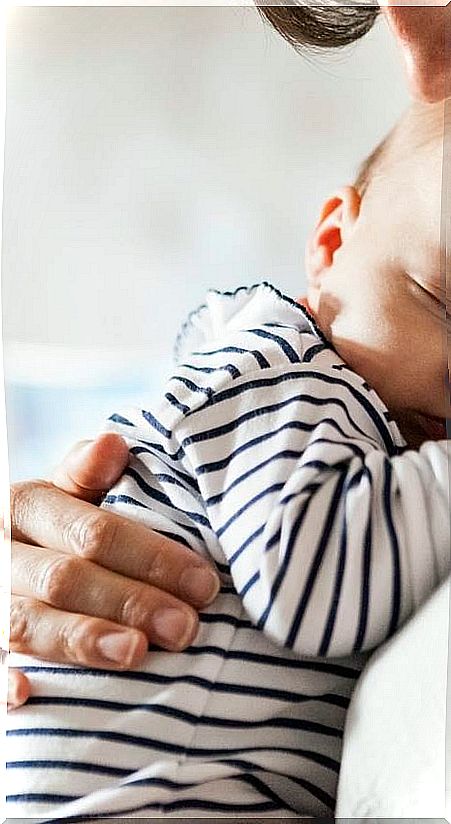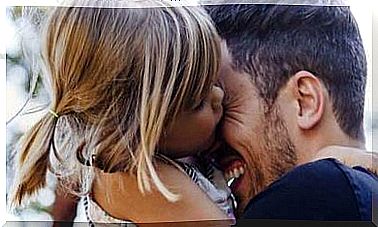Attachment Theory: Love Is A Vital Need
Attachment is a basic need for human beings. British psychiatrist John Bowlby was the first to study how this powerful bond is established in childhood.

Attachment theory describes how every human being has the basic need for survival to establish and maintain a strong affective bond, a first relationship with our primary attachment figure, usually the mother.
Attachment is a vital necessity as basic for babies as food, which is why the relationship of affection between parents and children during the first years of life as capital for their psychological development.
It is not about giving children everything they want, but about offering them comfort, presence and attention.
The origin of the theory: studies on affection and abandonment
The British psychoanalyst John Bowlby (1907-1990) was the one who developed the attachment theory from his work with juvenile delinquents, whom he had treated in a clinic specialized in children with problems.
There he observed that the children who stole were not those who had been fed when they were hungry, or comforted when they cried, not even those who had left toys uncollected. They weren’t the kind of kids that many consider “poorly bred.” It had nothing to do with all that.
He saw that the problem was not only psychological, but also social and economic, and that, among the psychological factors, stood out “certain factors that inhibit the ability to form relationships.”
He carefully studied 44 children and adolescents, sent to his clinic for stealing (from their own mothers, other children, in shops or at their workplace). He observed that almost all of them had psychological problems, classifiable into five different types.
- Lack of affection was the most frequent problem (14 children), especially among the most serious cases, those who had been stealing for a long time with great frequency: “children who lack normal affection, shame or a sense of responsibility”.
- A prolonged separation: Twelve of these 14 children without affection, and another five, had suffered a prolonged separation from their mothers in early childhood (more than six months).
- Repeated separations: Several had suffered repeated separations or had been through multiple foster homes.
- Ignored children and anxious mothers: Of the other 27 children who had not suffered a prolonged separation, some were despised or ignored by their fathers, others had mothers with behavior problems, anxious or who constantly scold them. Only in seven cases was the mother “quite normal.”
On the other hand, of 44 other children who came to his clinic for other problems but had not stolen, none had a character “without affection”, and only five had suffered long separations from their mothers.
Those first observations were published in 1944, in the International Review of Psychoanalysis , under the title “Forty-four Juvenile Thieves: Their Characters and Family Life .” Initially it was not very well accepted.
The prevailing psychoanalytic theories said that what matters is not the facts of real life, but the fantasies of the subconscious, and that the psychiatrist should not talk with his patients about what has really happened to them, but about their dreams.
Early separations: the relationship with the mother
Attachment theory states that it makes no difference whether the separation is from the biological mother or the adoptive mother.
E l boy loves his mother (or mother figure), although this does not treat them well.
If the mother is irritable, always criticizing and scolding, the resulting frustration will produce anger and aggression in the children. This frustration will increase the child’s desire for affection and displays of affection, but it will also direct his aggressiveness towards the mother.
However, since the child also loves his mother, he will feel very anxious and guilty about having bad impulses towards her. This will lead to a variety of pathological reactions, usually the formation of a rebellious and boastful character.
Investigations with orphans
Because of her extensive experience in caring for children and her interest in the effects of separation, Bowlby was commissioned by WHO in 1949 to report on how best to treat the many orphans of World War II.
That led him to speak to experts from around the world.
- Anna Freud, who had studied children evacuated from London during the bombings.
- René Spitz, who had described “hospitalism”, the serious mental problems suffered by young children admitted to a hospital without the company of their mother.
- Konrad Lorenz, the founder of ethology, who studied the mother-child bond in birds.
- Harry Harlow, who was studying the effects of separation on baby monkeys.
Finally, a summary of their report was published in book form, Maternal Care and the Growth of Love . There the germ of attachment theory appears , later developed in his trilogy Attachment and loss, and in other books.
John Bowlby’s attachment theory
Basically the attachment theory of John Bowlby says that attachment (the strong affective bond) is a basic human need, and (almost) all children establish a first relationship with a primary attachment figure, which is usually the mother.
Later they will establish other relationships throughout their lives with secondary attachment figures: the father, grandparents, siblings, close friends, spouse, children …
When the child separates from his attachment figure, he does a series of things in order to regain contact: depending on age, cry, call, talk, walk … The end result is the meeting, with which the behavior of attachment disappears (for the moment) and the child continues to his own.
Perhaps the newest part of the theory is stating that attachment is a basic need. Before, the Freudian theory of the secondary drive predominated : Babies have a primary need, which is food. Since it is almost always the mother who feeds them, they end up associating the mother’s presence with the satisfaction of that need, and they want to be with their mother, even when she is not hungry.
Bowlby says no, that it is not secondary, that the need for contact is as important as the need to eat.
Food and attachment are two basic human needs, and comparing them helps us understand them. We eat all our lives, but different things and in different ways.
All our lives we have attachment, with different people and manifesting it in different ways. The baby cries when his mother leaves the room; the adult calls his family when he is traveling.
What is attachment for?
Attachment is believed to protect against predators. An example: the sheep is safer in the herd, but the sheep does not think “a wolf may come”, as it does not think “I need protein”. You are simply hungry or lonely. Although the wolf is almost extinct, the sheep is still gregarious.
The baby behaves the same, even if he is not in any danger and mother is going to come back for a minute: he cries as if he was abandoned. He is not thinking “Mom will not come back”, he is not thinking anything, he is a baby. Simply, the babies who have behaved like this are the ones who have survived, for millions of years.
When he is able to think, around the age of three, “Mom will come back in the afternoon, and in the meantime my grandfather will take care of me, or the lady, or the babysitter, and I am not in any danger,” he will stop crying every time Mom leaves. . He continues to have attachment, but he does not show it the same.
Have you been told that “if you hold him, he will want your arms all day long”? That’s as ridiculous as “if you feed it, it will eat all day.” When he starts crawling and walking, he won’t want arms all day, just long enough to check that Mom is back, and then keep exploring.
Types of attachment
Mary Ainsworth, a disciple of Bowlby, developed the strange situation test, which makes it possible to assess how the child (from 9 to 18 months) is attached to his primary caregiver (usually the mother).
The test consists of the mother leaving the room and returning in three minutes. The most characteristic data is the child’s response when his mother returns.
- The securely attached child plays and explores when he is with his mother, tends to cry desperately when he leaves, asks for arms when he returns, and quickly calms down and starts playing again.
- The avoidant insecurely attached child cries little when the mother leaves and does not seek contact when she returns. He avoids his mother, he denies her gaze.
- The child with resistant insecure attachment cries and cries when the mother returns, beats her and is not consoled, takes a long time to explore again.
These three types of attachment are “normal” in the sense that none of them is a mental illness. There are three different strategies that children develop according to the treatment received during the first months.
The type of attachment has nothing to do with breastfeeding, or co-sleeping, or carrying around in the arms or in the stroller. In the first studies, in the United States, in the 70s, when almost no child breastfed for more than a few weeks, when holding them in the arms or putting them in bed was prohibited, these were the results:
- 65% had a secure attachment,
- 20% an avoidant addiction, and
- 15% a resistant addiction.
In African children who breastfeed for three years and hang on their mother’s back all day, the proportions are very similar.
How are they formed?
Secure attachment: it is formed when the baby sees that habitually (not “always”, it would be impossible) they comfort him when he cries and attend to his needs.
Avoidant attachment: it is formed when the baby sees that many times they ignore him or do not comfort him. It is so painful to ask your mother for comfort and for her to deny it to you, that the baby prefers not to ask for anything, so as not to receive a new refusal.
Resistant attachment: occurs when the mother’s response is unpredictable, sometimes she heeds it and sometimes she doesn’t. If they only listen to me half the time, I’ll have to cry twice as much.
Disorganized attachment: This type of attachment is abnormal, and corresponds to children who simply have not managed to establish a strategy, because nothing seems to work. It sometimes occurs in abused children.
Secure attachment and comfort
When no mother dared to take the child in her arms, because everyone said that they were “spoiled”, the majority continued to comfort the crying. They went to the crib, talked to the baby, smiled at him, sang to him, and the baby developed a secure attachment.
Instead, it is possible to hang on to the child and ignore him, to go about your business regardless of whether he is comfortable or uncomfortable, even forcing him to be in your arms when he is asking to get down and play.
It is not the same to “pay attention to the child” when he cries than “to give him what he asks for.” If your child asks for a piece of candy, you can give it to him, or not. But whether you give it to him or not, you can listen to him or not.
- You can give him the candy in the plan “here, darling, have this candy” or in the plan “that’s fine, you got me fed up, you’re spoiled, take the candy and shut up at once.”
- You can say “no, honey, not a candy, they are bad for the teeth” and try to distract him with something else, or yell “shut up, I told you no, and it is that no, you are capricious”.









